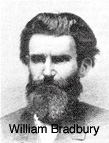 In the 1860 William Bradbury introduced a new approach to song in American Sunday schools. Both the musical style and the texts of his songs were in sharp contrast with Sunday-school songs from the first half of the 19th Century that had relied heavily on the old Psalm tunes and texts from Watts’ Divine and Moral Songs.
In the 1860 William Bradbury introduced a new approach to song in American Sunday schools. Both the musical style and the texts of his songs were in sharp contrast with Sunday-school songs from the first half of the 19th Century that had relied heavily on the old Psalm tunes and texts from Watts’ Divine and Moral Songs.
The prefaces to his Sunday-school hymnals reveal much about Bradbury’s vision for a new kind of song for children. In his Oriola: Hymn and Tune Book for Sabbath Schools (2nd edition, 1864) says that good singing is what makes Sunday school popular—not just any kind of singing but singing that is “characterized by sprightliness and cheerfulness, tempered with gentleness.” In a footnote he cites the Lee Ave Sunday School in Brooklyn, New York as “an illustration of the power of music as an agent for good in the Sunday School.” The heart of his philosophy of tunes is found in these words from the preface of Oriola:
We do not believe in the stiff, old-fashioned way many have of keeping the children singing nothing but Old Hundred, Dundee, Mear, St. Martins, and such like. Good old tunes these, no one will deny, and should be sung from time to time, but they are not in any peculiar sense children’s tunes, and the children should not be limited to them. The popular tunes for children should be as simple as their own thoughts, -sprightly as their own dispositions. Lambs require plenty of skipping room. They thrive best in the green fields. Let the children's songs, then be such as they can understand, appreciate and enjoy; such as they will love to sing both in the Sabbath School and at their homes. These will ever be to them a source of delight, and will render the school doubly attractive.
A new kind of text was also important to Bradbury. A good example of the older approach is found in the 1854 Protestant Episcopal Sunday-school hymnal with its use of 11 of the 28 Divine and Moral Songs by Isaac Watts. These new hymns emphasized the love of Jesus and his return, deemphasizing God's "dreadful majesty" and “piercing eye.” Bradbury speaks of this new emphasis in the preface The Golden Censer (1864):
An ardent love for the employment, and a pretty extensive acquaintance with leading Sabbath School friends throughout the country, has brought to the author’s aid a host of valuable assistants –writers of some of the sweetest hymns in our language, and many of these, ladies, whose devotion to the cause has inspired their pens with heavenly ardor. These hymns are brimful of the Gospel, and if they do not sing themselves right into the hearts of both teachers and children, the fault must be in the music, and not in the hymn.
According to Bradbury the goal of this new kind of Sunday-school song was twofold: as an “attraction” that would “draw into the school many who would otherwise spend the sacred hours of the Sabbath in the street,” and as a “most delightful and successful means of communicating Gospel truths.” He pointed out that the Gospel could be sung into the hearts of children in ways that might not be possible through traditional teaching. And then to drive home his point he launches into a bit of 19th century hyperbole, quoting song titles from his hymnal: “Sweet music opens these hearts, and bearing upon its angel wings ‘Heavenly Breezes’ –precious words of ‘Invitation’ – thoughts of ‘The Cross’ and the ‘The beautiful Land,’ which is ‘The Christian’s dear Home,’ it awakens emotions of tenderness, love and contrition.” (The Golden Shower,1862)
Bradbury drew from popular music resources of his day: the campmeeting songs that had swept the country from the beginning of the 19th century; and the parlor song sold in the form of sheet music—a well-established commercial enterprise by the 1850s. The presence of the chorus or refrain in both of these forms was very attractive to him. In his preface to The Golden Censer (1864) he calls the refrain “that most popular and appropriate modern feature” of this new kind of Sunday-school song which could be “sung as children only can sing them.” He argued that the refrain could “fasten like ‘a nail in a sure place’ the sentiment of the hymn.”
Bradbury's sunday-school songs became the model for the so called "gospel hymns" used by the evangelist D. L. Moody and his music director Ira Sankey in their campains that began in the 1870s and drew large audiences in the British Isles and the United States. Bradbury's EVEN ME was used extensively by Moody and Sankey and has had a long life in evangelical circles.